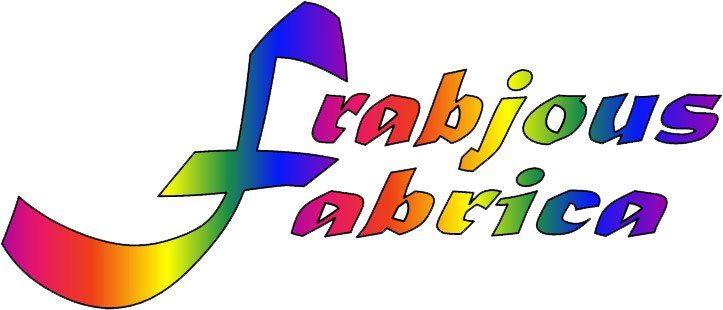
Frabjous Fabrica - Fine Art, Fabrics, Clothing and Accessories
Joyously created from Fibres, Yarn and Fabrics
Why Frabjous Fabrica? The word Frabjous is from Lewis Carroll's poem "Jaberwocky" and it means “joyous, wonderful, elegant, superb, or delicious.” Fabrica is Latin and means "something skilfully produced".
I live in North Dorset and have been making felt in various guises since early this century, having attended a workshop at the Dorset Guild of Weavers Spinners and Dyers. I love working with textiles and fibres in particular and spend as much time doing so as I can now that I am retired.
About Ann
An intense dislike of needlework, as taught at her school. did not prevent Ann from acquiring basic dressmaking skills, if only to eke out pocket money in her teenage years. Her current experience and skills are the result of much subsequent investigation and experimentation on her own behalf.
Her burgeoning interest in various crafts followed marriage and a move to a country village in Kent where she joined the WI. For some reason which now eludes her she decided to make a Regency Era cloth doll. The dressing of the doll had to be as authentic as possible which, for example, meant that the lace edging to the garments would have to be hand-made.
This lead to a venture into bobbin lace, subsequently abandoned as the results were too coarse despite the use of the finest threads then available. Needle-made laces then became an absorbing study, as did other methods of making lace without bobbins: crochet, macramé, Tenerife lace, Dresden lace and, of course, tatting (different type of bobbins). This resulted in a small travelling demonstration/exhibit which appeared at various venues in Kent.
With a view to creating figured fabrics for the doll's costume, the various branches of embroidery were investigated and a foray into needle painting culminated in a pair of heron pictures.
During the lace and embroidery phase, Ann was attending a popular annual craft fair at the tiny church at Harty on the Isle of Sheppey, where she was coming into contact with artisans in other craft disciplines. She began to realise that she had contracted an addiction for fancy yarns, amassing quite a collection of these for embroidery and crochet; she also began hand-dyeing yarns. The addiction widened to fibres, both natural and synthetic, and various types were finding their way into her stock, provoking an interest in spinning and weaving and her subsequent membership of the then Medway Spinners and the Kent Guild of Weavers Spinners and Dyers.
Ann has never been cured of her yarn and fibre addictions although her methods of working with them have changed over the years. After her 1999 move to Dorset (away from a rural Kent fast disappearing under concrete and tarmac), where she became a member of the Dorset Guild of Weavers Spinners and Dyers, she was introduced to her present love - felt making. Getting on for 20 years ago, a member of the Guild - Eileen Sarup, a textile artist working in felt, ran a workshop teaching basic felt making - and Ann was hooked. A subsequent workshop in needle felting by Eileen doubled the effect. The more Ann researched the history of felt, the more ensnared she became, and the more felt she made the more she had to make - another addiction!
Ann has been fascinated by the effects which can be obtained with various fibres in felt making. She finds it disappointing that blends of different coloured tops (fibres, usually woollen, which have been machine prepared to lie in one direction) lose their special appeal when spun into yarn; but such fibres laid out and made into felt retain the original effect.
Attendance at another workshop learning how to make a nuno felt scarf sent Ann down the avenue of the various ways scarves and other accessories could be made using felt. The basic nuno method (laying the fibres onto fine fabrics such as gauze, muslin, chiffon or organza so that when felted they pass into the fabric and become one with it) could be adapted to make a very fine scarf by using the fibres sparing so that the fabric was predominant. Alternatively, the fabric could be completely covered on one or both sides with fibres making a garment which was much stronger than its weight might suggest. Experimenting with the various effects obtainable resulted in mountains of scarves and accessories, and Ann had to resort to selling them just to keep her head above the pile!
Lengths of tops, either monochrome or rainbow hued, when felted make very attractive scarves or fabric which can be gossamer thin - fashionable for the cool summer evening, or thick for warmth in winter - and even with a matching hat, mittens, boots and bag! These latter items sent Ann off in another direction - hats, and seamless vessels of different types, and latterly funerary urns.
While all these experiments have been going on, Ann has also been working with felting needles. These needles are manufactured for use in industrial felt making machines, but when manipulated singly (or several together in a holder - in Ann's case specially made for her by her engineer husband) it is possible to create felt without the need for soap and water. Originally Ann began creating pictures in the style of Chinese Brush Painting and water colours, then moved more into the third dimension, giving some bas relief to the subject of the "paintings". Subsequently she has created complete "sculptures".
Ann's felt "paintings" have developed into more detailed affairs, with extra detail added with embroidery. She has blended the colours for her palettes herself, since it is almost impossible to obtain ready dyed fibres in all the colours she needs, and has spun some of these to make yarns to use alongside those selected from her now enormous stash of different types of embroidery threads. She actually tried to keep track of the time she takes to complete one of the pictures she made on commission and gave up after logging over 144 hours, and that didn't include the initial consultations, sketches, finishing the work and final framing. At the then £7.50 National Living Wage, the price charged for the commissioned picture should have been well over £1000.00 - it's a good job she does the pictures for fun and not to make a living!
Since joining the Sturminster Newton Amateur Dramatic Society (SNADS) Ann has helped with costumes and makeup, as well as - as she puts it - making a fool of herself on stage. In addition to the usual fabric costumes, felt has appeared several times, in the shape of full head animal masks, and also on Long John Silver's wooden leg!
Since moving to Dorset, Ann has been regularly entering her work in the Annual Exhibition of the Dorset Arts and Crafts Association, usually held during the first week in August. She has been awarded over 50 Certificates, including more than 10 Gold (work of outstanding merit). She has exhibited several times in The Bibbern Gallery, at The Exchange in Sturminster Newton, and taken part in various other exhibitions around the South West.
And the cloth doll which started all this? Languishing still bald, blind and naked in Ann's workshop. Who knows maybe she will be finished one day!




